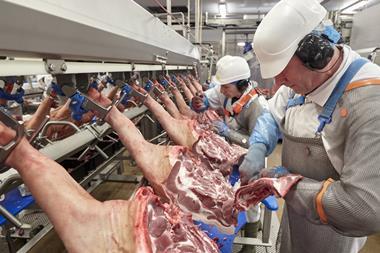Helping consumers forget the negative side'
As tempers cool in the pork and bacon trades after the Meat and Livestock Commission's highly controversial advertisements, it is becoming clear the campaign was designed at least in part to tackle a market problem much broader and deeper than the squabble between British, Danish and Dutch pig producers.
The press ads one highlighting pig housing conditions; the other livestock feed were interpreted in Denmark and Holland as an unfair attempt by the British to turn this country's ban on stall and tether systems and prohibition of meat and bone meal to commercial advantage.
Producers here certainly want shoppers to believe animal welfare standards are lower on the continent.
However, the campaign strategy and graphic design of the ads reflected MLC research findings clarifying a contradiction in consumers' attitudes to meat eating and animal welfare, and even suggesting a need for a less partisan marketing approach.
For years many traders have tried to ensure consumers are not reminded meat comes from livestock. The most thorough of MLC's new studies partly vindicates this, noting supermarket pork shoppers have "serious worries about seeing the skin and hairs anything that signals this is an animal".
Yet the research paper argues the challenge is more subtle than merely facilitating denial.
Consumers tend to be committed to both animal welfare and the enjoyment of meat eating, recognise these are conflicting objectives, and need the industry's help in reconciling them.
One conclusion suggested by the MLC study is a need for "rebranding" animal welfare into "more socially acceptable terminology" to help consumers accommodate their scruples without feeling compelled to reduce purchases.
{{MEAT }}
Close menu
- Home
- Retail & Wholesale
-
Products & Suppliers
- Back to parent navigation item
- Products & Suppliers
-
Product Categories:
- Back to parent navigation item
- Product Categories:
- Alcoholic drinks
- Bakery
- Cereals & breakfast
- Cheese
- Chicken & poultry
- Chocolate
- Confectionery
- Crisps, nuts & snacks
- Dairy
- Fish
- Fresh produce
- Frozen
- Household
- Meat
- Own Label
- Sauces & condiments
- Seasonal
- Soft drinks
- Vaping
- Vegan & plant-based
- World foods
- Suppliers
- People
- Reports & Data
-
Topics A-Z
- Back to parent navigation item
- Topics A-Z
-
Popular topics:
- Back to parent navigation item
- Popular topics:
- Cost of living crisis
- Crime
- Deposit Return Schemes
- Finance
- Government & Regulation
- Health
- Inflation
- Loyalty
- Marketing
- Mergers & Acquisitions
- New Product Development
- Sourcing
- Supply chain
- Sustainability & environment
- Technology
- Ultra Processed Foods
- Vaping
- A-Z all topics
- Content by type:
- Events
- Subscribe now
Sign in to comment on this article
Not logged in before? Register for FREE guest access today.
You will be able to:
- Read more stories
- Receive daily newsletters
- Comment on stories
Advert


















No comments yet